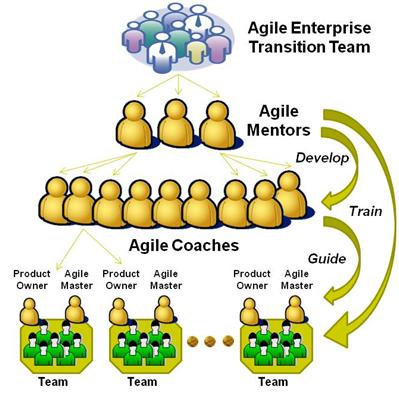
We are now collaborating to identify the training and consulting patterns that can be applied for a, rapid enterprise-scale adoption (enterprise-scale: an agile transformation that will impact many hundreds, and potentially thousands of practioners in a time frame of less than one year.) Since there are a number of new team-based and organizational practices that must be mastered for a successful enterprise transformation (refer to Dean’s book) we’ve identified three key transition mechanisms required to facilitate practice adoption and fan out a consistent, effective and disciplined process across the organization. These are 1) the establishment of an internal agile enterprise transition team, 2) an agile training program reaching most practitioners and 3) and effective coaching and mentoring program.
First, and foremost, the creation of an internal agile enterprise transition team drives the enterprise vision for the agile transition and also facilitates its implementation. Implemented properly, it re-orients the transition from a top-down mandate to a middle-out and bottom-up buy-in of the impending change. Transition teams are not a new concept and have been well documented by William Bridges in his book Managing Transitions: Making the Most of Change. More recently, Ken Schwaber has written about the importance of a transition team for large-scale Scrum adoption in his book The Enterprise and Scrum. We will write more on our experiences incorporating transition teams in upcoming posts.
Secondly, shared-learning achieved through outside training is a critical success factor in an enterprise-scale transition. This addresses the basic need for understanding, mastery, consistency, and coordination of the many new techniques across the multiple interdependent teams that are necessary to deliver large-scale business solutions in a substantially agile manner. Due to the self-organizing principles of agility, teams can (and will) eventually adapt the initial practices to better suit the needs of the organization. Building a common vocabulary and understanding of the principles behind the practices first will help align the whole organization and drive a consistent, yet truly agile approach. Dean and I provided a team and role-based framework for this training in Dean’s recent blog posting – Ideal Training for Enterprise-Scale Agility?
Last, but not least, is the need for experienced agile mentoring and guidance. While training is necessary for an enterprise consistency and understanding of agility, it is not sufficient. Training is often separated from the reality of the environment and project issues teams face. Moreover, fully leveraging an ideal training scenario is not always practical and gaps in understanding as well as practice will certainly remain. This is the main driver for the third mechanism, facilitating an engagement with experienced, outside agile mentors.
Experienced agile mentors help teams solidify their understanding of agility and its principles through repeated practice. Agile mentoring facilitates process adoption by leveraging experience from other organizations that have already walked that path. Mentoring guides process, product, project and functional leaders through their changing roles and responsibilities. Mentoring also assists with the organizational alignment in creating dedicated, focused and high-performing teams.
A single-tiered mentoring model, used in most small and mid-sized agile transitions, leverages one or more outside agile mentors to guide individual teams. This provides a direct and proven knowledge transfer mechanism that are effective for small and midsize organizations. This approach eventually supplies the organization with a number of internal agile team leaders, and has been effective at smaller scales. At enterprise scale, however, it may be prohibitively expensive (requiring a substantial number of outside consultants) and too slow for large-scale enterprises that want the benefits of agility (higher quality, better responsiveness, improved morale) sooner, rather than later.
To date, larger enterprise-scale agile transition models have primarily been phased in over many years, essentially building on top of many smaller-scale pilot projects and transition efforts. British Telecom is one such example as recorded in their 2007 Scrum Gathering presentation – Scrum@BT. Geoff Watts and Paul Goddard write that their organization has been transitioning to Scrum since 2003, when they certified their first ScrumMaster.
Having guided both incremental and all-at-once transitions, there is a compelling corporate synergy, alignment and focus that occurs when an organization attacks a problem all-at-once. The shared focus and experiences more quickly surface organizational issues and impediments and leadership is more acutely aware and prepared to respond. The organization moves much more quickly through the discovery phase and into a delivery and adaptation phase of the transition. The leveraged mentoring model that we propose as presented in Figure 1 below provides a less costly and more rapid transition while equipping the organization with agile leaders who are capable of supporting and guiding its ongoing evolution and adaptation.
Figure 1: An Agile Coaching Model for an Enterprise-Scale Transition
Unlike single-tier coaching models and longer-term phased transition models, this model introduces internal agile coaches at the outset of the transition. By developing internal agile coaches early in the transition process and actively engaging them throughout the training and early mentoring activities, they have an opportunity to develop the skills necessary to introduce and transition other teams within the organization, and over time displacing the external agile mentors used to seed the transition. The experienced outside mentors act as the initial catalysts for change, whereas the agile coaches provide the ongoing support, consistency and growth for the agile adoption to embed into the culture of the organization. Moreover, it’s likely that these internal coaches will have an understanding of the issues and challenges the teams face internally, and in the marketplace.
In other words, another benefit of this, model is that it provides a proving ground for the future leaders of a truly agile enterprise.
